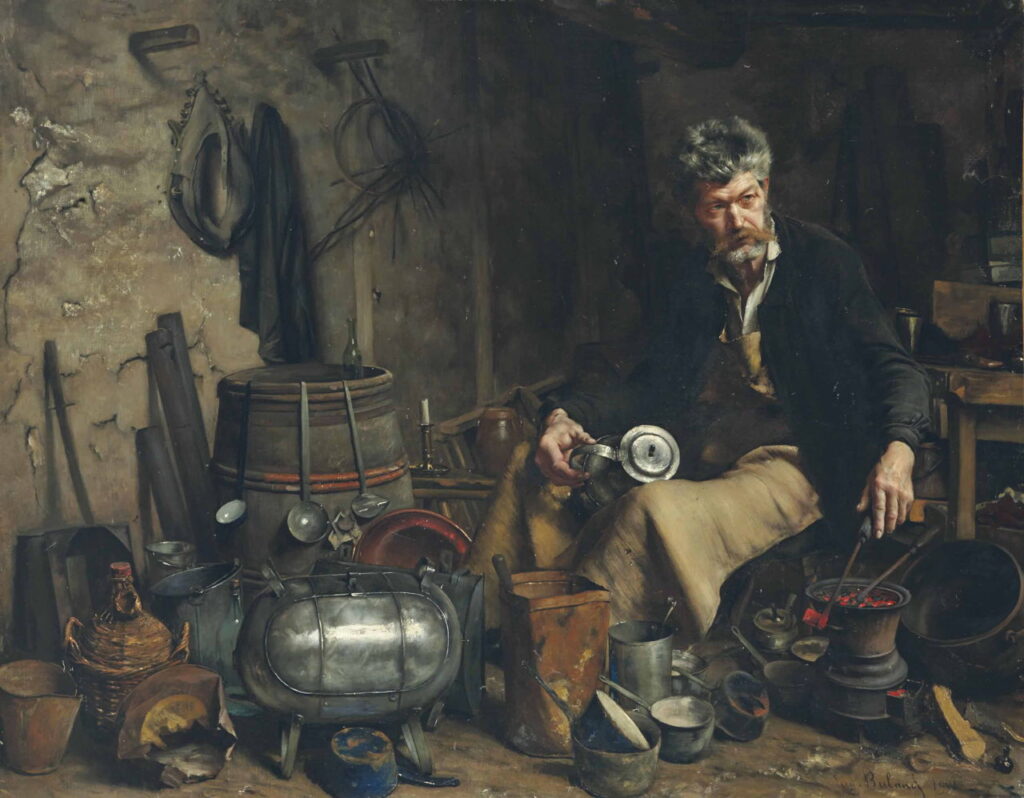The Real Country: Trades

Those living in the country succeeded largely by self-help. Many skills were common knowledge, augmented by advice and help from the more experienced. If your roof was leaky, then you didn’t normally call in a roofing specialist, but repaired it yourself with the aid of family and friends.
James Ward (1769–1859), An Overshot Mill (1802-1807), oil on panel, 27.6 x 33.3 cm, Yale Center for British Art, New Haven, CT. Wikimedia Commons.
It’s unlikely that the people working on the thatched roof of James Ward’s Overshot Mill (1802-1807) were specialist thatchers, whose services could only be afforded by the more wealthy.
Léon Augustin Lhermitte (1844–1925), The Haymakers (1887), oil on canvas, 216 x 264 cm, Van Gogh Museum, Amsterdam, The Netherlands. Wikimedia Commons.
Most tools were simple in design and construction, and rustic. Sharpening the blade of a heavy scythe used for mowing was performed by beating it with a hammer, as shown in Léon Augustin Lhermitte’s painting of The Haymakers from 1887. Finer blades were normally brought to a keen edge using a whetstone.
Working in iron and other metals required not only specialist skills but equipment possessed by the local blacksmith, who made and fitted shoes on horses, put rims on wooden wheels, and fashioned iron hinges for doors.
Francisco Goya (1746–1828), The Forge (1812-16), oil on canvas, 181.6 x 125.1 cm, The Frick Collection, New York, NY. Wikimedia Commons.
Francisco Goya’s Forge from 1817 is a superb depiction of the physically demanding work of the blacksmith. Its extensive use of black is also a herald of the Black Period to come in Goya’s paintings at the end of that decade.
Alfred Sisley (1839-1899), Forge at Marly-le-Roi (1875), oil on canvas, 55 x 73.5 cm, Musée d’Orsay, Paris. EHN & DIJ Oakley.
These had changed little in the latter years of the nineteenth century, as seen in Alfred Sisley’s Forge at Marly-le-Roi from 1875, although a little more light is being cast in through its glass window.
Ernst Josephson (1851–1906), Spanish Blacksmiths (1882), oil on canvas, 128.5 x 107 cm, Nasjonalgalleriet, Oslo, Norway. Wikimedia Commons.
Ernst Josephson’s Spanish Blacksmiths from 1882 shows a smith in the shredded remains of his white shirt, and his ‘striker’ to the right in his black waistcoat, with a horseshoe hanging below the roof of their forge in Seville.
Döme Skuteczky (1849–1921), In the Smithy (1897), mixed media, 28 × 21 cm, location not known. Wikimedia Commons.
Döme Skuteczky’s painting In the Smithy from 1897 shows another smithy, this time in Slovakia.
Joseph Wright of Derby (1734–1797), An Iron Forge (1772), oil on canvas, 121.9 x 132.1 cm, The Tate Gallery, London. Wikimedia Commons.
With the industrial revolution, hammers grew too large to be wielded by a man, and relied on first water- then steam-power. Joseph Wright of Derby’s An Iron Forge (1772) is one of his series of faithful portrayals of the small-scale technological advances of the day. It shows a group of workers forging a white-hot iron casting, using a tilt-hammer powered by a water-wheel. Also present is the wife and children of the iron-founder, stressing the family nature of these small forges at the time.
Jean-Eugène Buland (1852–1926), The Tinker (1908), oil on canvas, 112.6 × 145 cm, Private collection. Wikimedia Commons.
Not all metal-working was heavy and large-scale. Jean-Eugène Buland uses his Naturalist style to depict The Tinker (1908), who repaired damaged pots, pans, and domestic metal objects in a cottage industry that predated the Industrial Revolution.


